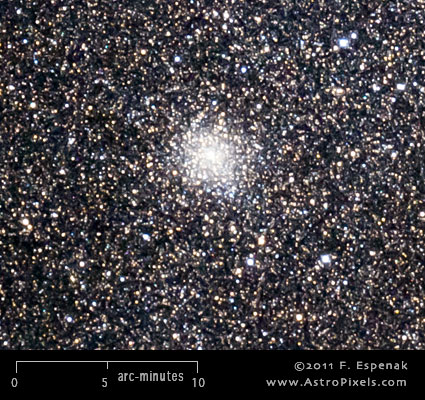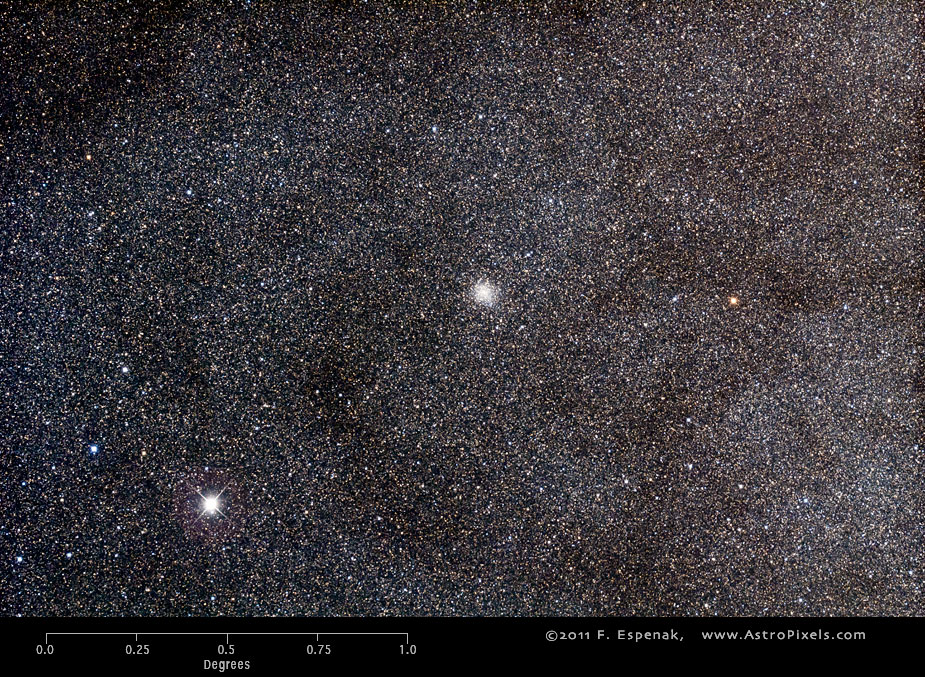
M28
Messier 28 or M28 (also designated NGC 6626) is a globular cluster in the constellation Sagittarius. It has an apparent visual magnitude of 6.8 and its angular diameter is 11.2 arc-minutes. M28 lies at an estimated distance of 18,600 light years. The Equinox 2000 coordinates are RA= 18h 24.5m, Dec= -24° 52´ which makes M28 best seen during the summer. The Messier Summer Star Chart shows the position of all Messier objects visible during that season.
The image above shows the uncropped view of M28 through the Takahashi E-180 Astrograph (North is up). The bright star visible one degree southeast of M28 is Lambda Sagittarii (magnitude 2.82). A 3x enlargement of this image centered on M28 appears to the right.
This globular cluster was discovered by Messier in 1764 but he could not resolve it into stars. According to Recio-Blanco et al.(2005), the distance of M28 is 34,480 light years and its diameter is 100 light years. Its estimated mass is 500,000 solar masses and it contains 19 variable stars.
For more information, see the Messier Catalog as well as specific entries for M28 in Wikipedia and SEDS.
Messier's Description of M28
July 27, 1764
`Nebula discovered in the upper part of the bow of Sagittarius at about one degree from the star Lambda and little distant from the beautiful nebula which is between the head and the bow [M22]. It contains no star; it is round, it can only be seen difficultly with an ordinary telescope of 3.5 feet. Its position has been determined from Lambda Sagittarii. Reviewed March 20, 1781.' (diam. 2')
Technical Details
- Object: M28
- Other Names: NGC 6626
- Object Type: globular cluster
- Object Data: Apparent Magnitude = 6.8, Angular Size = 11.2 arc-minutes
- Object Position (Equinox 2000): RA= 18h 24.5m, Dec= -24° 52´, Constellation = Sagittarius
- Date/Time: 2011 May 06 at 10:43 UTC
- Location: Bifrost Astronomical Observatory, Portal, AZ
- Mount: Astro-Physics 1200GTO
- Telescope: Takahashi Epsilon 180 Hyperbolic Astrograph
- Camera: Canon EOS 550D (Rebel T2i) (modified with a Baader UV/IR filter)
- Field of View: 1.70° x 2.56° at 1.7 arc-sec/pixel (web version: 10.0 arc-sec/pixel)
- Exposure: 6 x 300s, f/2.8, ISO 800
- File Name: M28-01w.jpg
- Processing (Adobe Camera Raw): Graduated Filter, Vignetting Correction, Noise Reduction, White Balance, Curves
- Processing (Photoshop CS5): Average Images, Curves, Noise Reduction
- Original Image Size: 3454 × 5179 pixels (17.9 MP); 11.5" x 17.3" @ 300 dpi
- Rights: Copyright 2011 by Fred Espenak. All Rights Reserved. See: Image Licensing.
